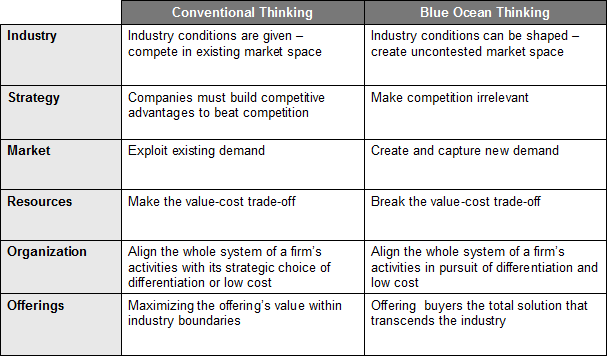Blue Ocean Strategy is growth strategy framework focused on the idea of creating an uncontested market space–i.e. a “blue ocean.” This framework is very innovative, as its principles challenge the conventional business strategy principles of fighting competitors head-on. The Blue Ocean Strategy framework evolved from a framework called Value Innovation developed by Gemini Consulting (now Capgemini Consulting) in the late 90s.
Blue Ocean vs. Red Ocean. What’s the meaning behind the name?
In red oceans, our efforts are focused on the conventional logic that we must outpace the competition with a better solution to a given problem. Blue ocean strategy invites us to redefine the problem itself. It does so by breaking the value-cost trade-off in view of creating new uncontested market places. Places where no one has been and where we would be the one defining the rules!
The Analytical Tools & Frameworks
The strategy canvas is both the start and the end point of a Blue Ocean Strategy formulation. An initial value curve depicts where the industry competes on and invests in. It is then transformed via the eliminate-reduce-raise-create actions framework. The resulting value curve shows a focused effort that diverges from existing market offerings and can be easily translated into a compelling tagline.
Core Underlying Principles
Venturing beyond an existing industry space implies a series of risks. The blue ocean strategy approach to strategy is based on six principles that cater for the major risks of a new market creation project: search risk, planning risk, scale risk, business model risk, organizational risk and management risk. Together, they define the underlying philosophy of blue oceans.
Flevy is the marketplace for premium business documents, such as business frameworks, PowerPoint templates, financial models, and more. We have two beautifully crafted presentations focused on explaining the Blue Ocean Strategy framework here on Flevy:
Value Innovation
At the heart of Blue Ocean Strategy, we have concept of Value Innovation. Value without innovation tends to focus on value creation on an incremental scale, i.e. something that improves value but is not sufficient to make us really stand out in the marketplace. Innovation without value tends to be technology-driven, market pioneering, or futuristic, often shooting beyond what buyers are ready to accept and pay for.
Value innovation occurs only if we align innovation with utility, price, and cost positions. The focus here is not time-to-market, bleeding-edge technology or best practices. It is the ambition to break one of the most commonly accepted dogmas of competition-based strategy: the value-cost trade-off.
It is conventionally believed that companies can either create greater value to customers at a higher cost, or create reasonable value at a lower cost. Here, strategy is seen as making a choice between differentiation and cost. In contrast, to create blue oceans, we need to pursue differentiation and low cost simultaneously, by looking within and beyond our industry boundaries and redefining a market altogether.
The right sequence for creating value innovation is (1) buyer utility, (2) price, (2b) profit, (3) costs, and (4) adoption.
- Buyer Utility – Does our offering unlock exceptional utility? Is there a compelling reason for the mass of people to buy it? By locating our proposed offering on the thirty-six spaces of the buyer utility map, we can clearly see how, and whether, the new idea not only creates a different utility proposition from existing offerings but also removes the biggest blocks to utility that stand in the way of converting non-customers into customers. If our offering falls on the same space or spaces as those of other players, chances are it is not a blue ocean offering.
- Strategic Price – Is our offering priced to attract the mass of target buyers so that they have a compelling ability to pay for it?
- Target Cost – Can we produce our offering at the target cost and still earn a healthy profit margin? Can we profit at the price easily accessible to the mass of target buyers?
- Adoption – Almost by definition, a blue ocean idea threatens the status quo. As a result, it may provoke resistance among employees, partners and the general public. Often underestimated or put aside because of its cost, educating the “fearful” can have a make or break impact on our new idea. Identifying threats to employees and third parties and openly discussing issues upfront helps minimize risks and defuse negative opinions that would be much more costly to address later on.
Instead of focusing on beating the competition, value innovation focuses on making the competition irrelevant by creating a leap in value for buyers and our company, thereby opening up new and uncontested market space. The objective here is not to increase our competitiveness in the market as we know it. Rather, it is to create a whole new market where the rules of the games are yet to be created, by us!
Learn More Frameworks
You may be interested in these other business strategy framework documents available on Flevy:

Do You Want to Implement Business Best Practices?
You can download in-depth presentations on 100s of management topics from the FlevyPro Library. FlevyPro is trusted and utilized by 1000s of management consultants and corporate executives.
For even more best practices available on Flevy, have a look at our top 100 lists:
- Top 100 in Strategy & Transformation
- Top 100 in Digital Transformation
- Top 100 in Operational Excellence
- Top 100 in Organization & Change
- Top 100 Management Consulting Frameworks
These best practices are of the same as those leveraged by top-tier management consulting firms, like McKinsey, BCG, Bain, and Accenture. Improve the growth and efficiency of your organization by utilizing these best practice frameworks, templates, and tools. Most were developed by seasoned executives and consultants with over 20+ years of experience.
Readers of This Article Are Interested in These Resources




